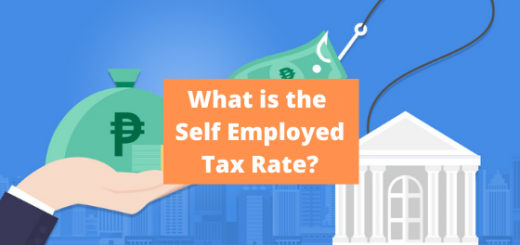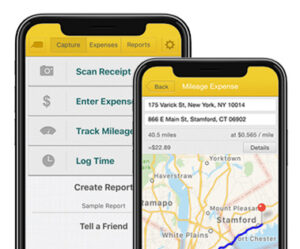How Self-Employed Pay Tax
Read this article to learn how self employed pay tax, learn when self employed tax is due, and how to calculate (with sample calculations).

When you’re an employee your employer withholds taxes from your paycheck each month. Therefore, most employees have paid all their taxes by the time it is the end of the year. However, when you’re self-employed it’s your responsibility to pay your taxes yourself.
Read on to learn about self-employed tax and how self-employed pay tax.
What is self-employed tax?
When you’re an employee your employer withholds three types of taxes from your paycheck.
Those three types of taxes are:
- Medicare
- Social Security
- Income Tax
Everyone pays income tax. However, when people refer to self-employed tax they typically mean Medicare and Social Security tax.
The total self-employment tax rate is 15.3%; 12.4% of that goes to social security and 2.9% goes to medicare.
As an employee your employer pays half of your medicare and social security tax, the other half is paid from your income. However, when you’re self-employed you pay the full amount of medicare and social security taxes at 15.3% of your income. This is likely why people call medicare and social security tax “self-employed tax” because it’s the extra tax you only pay when you’re self-employed. So if you’re asking yourself, what is self-employed tax? Now you know.
How self-employed pay tax
Self-employed pay tax every quarter to the IRS instead of once a year. So that means as a self-employed taxpayer you have four tax days a year, instead of one (like employees do). Despite the extra work you have to do to pay quarterly taxes, the freedom of self-employment is worth it.
Therefore, if you’re a self-employed sole proprietor you have to estimate annual gross income in advance
Why do self-employed need to estimate their annual income?
Self-employed need to estimate their annual income in advance because they pay taxes four times a year, known as quarterly taxes. With that said, your self-employed quarterly taxes, also known as estimated taxes, are calculated based on estimated annual taxable income. Therefore, every quarter, when you go to calculate your estimated tax payments, you use the income tax bracket to calculate the amount of tax you owe for the quarter based on your ’estimated’ annual taxable income.
In addition, this means you must also set aside the amount of money that you estimate your tax payment will be at the end of each quarter.
This can be done by setting aside your estimated tax payment in your personal checking account. However, it is much easier to set aside your estimated tax payment in a small business bank account.
By this point, you’re probably asking, can I open a business bank account if I’m self-employed or a sole proprietor?
The answer is, yes. You don’t need to have formed a formal legal business entity such as an LLC to open a small business bank account.
A business bank account makes it easier to separate your personal finances from your business finances. It also provides a dedicated account to safely store your estimated tax payments. Therefore, you don’t accidentally spend it when you make a personal purchase with your personal checking account.
There are many benefits of having a small business bank account. Read this article if you’re interested in learning how to open one: How to Open a Small Business Bank Account for Self-Employed.
Also, check out this article if you’re interested in forming a legal business entity for small business, Self-Employed vs Single-Member LLC: The Complete Comparison. In this article the advantages and disadvantages of a self-employed sole proprietorship are compared in the most complete comparison you will find on the web. So you don’t want to miss it!
What are quarterly taxes?
Self-employed pay taxes four times a year, that is every quarter, instead of once a year as employees of companies. Quarterly taxes are also known as estimated taxes.
It is recommended that self-employed put aside 25 to 30% of their earnings for taxes.
Why do self-employed pay quarterly taxes?
Who pays quarterly taxes?
Self-employed individuals such as sole proprietors, freelancers, small business owners, independent contractors that expect to owe at least $1,000 in taxes for all their self-employed income for the year.
Why do we say “expect to earn”?
Because estimated taxes (aka quarterly taxes) are calculated based on your estimate of your total annual taxable income. Keep reading to find out how to calculate estimated tax payments, with sample calculations.
What happens if you’re self-employed and owe less than $1,000 in taxes?
Then pay your taxes on an annual tax return.
Contact a tax professional if you’re not sure you’ll need to pay quarterly taxes.
How do you calculate quarterly taxes?
When are quarterly taxes due?
Jan. 1–March 31, April 15
April 1–May 31, June 15
June 1–Aug. 31, Sept. 15
Sept. 1–Dec. 31, Jan. 15 of the following year
How do self-employed actually pay tax?
The IRS provides quite a few ways for self-employed to pay tax.
Pay Online
Go to the IRS online payment page. From the IRS payment page set up online payments for your taxes using your bank account or a debit card.
Pay by App
The IRS has an app where to pay taxes. The IRS app is called, IRS2Go, and you can download it directly to your phone. Pay your taxes at any time, anywhere, with the app.
Go to the App Store and download it now.
Pay by Phone
To pay by phone, enroll for free in the Electronic Federal Tax Payment Service (EFTPS) and use their voice response system to pay your taxes over the phone.
Pay by Cash or Check
To pay this way, go in person to your local IRS office. Or mail in a check or money order.
How can self-employed reduce the amount they pay in taxes?
You only pay taxes on your ‘taxable income’. Your taxable income is the amount of income that remains after you subtract all qualifying tax deductions. Tax deductions are also known as write-offs. There are many tax deductions available specifically to self-employed taxpayers. Therefore, you want to make sure you are familiar with all of them, and take advantage of as many of them as possible. The smaller your taxable income the less you pay in taxes and the more you keep for yourself.
For example:
Your gross annual earnings are $50,000
Your tax rate is 20%*
*we’re using a random number for this sample calculation
How much tax you’ll owe if have no tax deductions:
$50,000 x 20% = $10,000 in taxes owed
How much tax you’ll owe if you deduct $15,000:
$50,000 – $15,000 = $35,000 in taxable income
$35,000 x 20% = $7,000 in taxes owed
In the example above you see that if you take advantage of self-employment tax deductions you increase the amount of money you keep by $3,000. That is a lot.
Related: The Compelte List of Small Business and Self Employment Tax Deductions
Conclusion
How self-employed pay taxes is a little bit more involved than how a regular employee pays taxes. However, now you’re equipped with everything you need after reading this article.
Bookmark this article and refer to it when you need to check an estimated tax due date, or refer to any information that is here. Or even better, add the estimated tax due dates to your calendar a few days before the actual tax due dates.
Then set it up so that you receive a notification on these days to remind yourself to pay your estimated taxes.
Feel free to reach out to us with any other questions and on of our tax professionals will happily answer them.
Was this article helpful?

I used to travel a lot for work. Doing my expenses frustrated me. I would delay submitting them and when I did, I would spend hours taping receipts to paper to scan for my boss. I knew there was a better solution, and I had a background in productivity software, so I created Falcon Expenses. I enjoy creating software that makes people’s lives easier.
In addition, I’m an avid skier and I enjoy hiking, sailing, and cooking.





